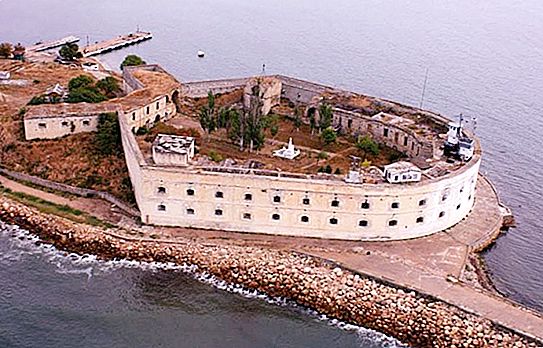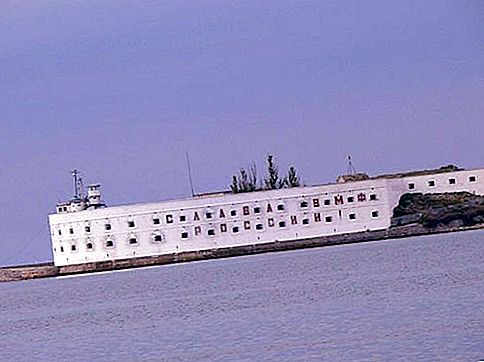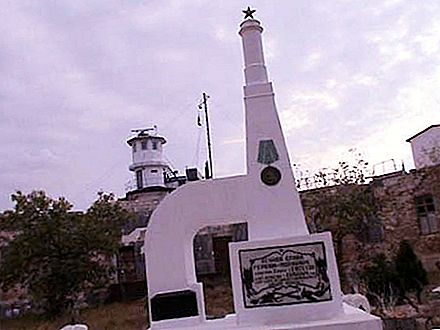The hero city of Sevastopol has repeatedly served as a powerful naval base and outpost. Its inhabitants repeatedly performed miracles of courage and heroism. To defend the Sevastopol raid, several defensive fortifications were erected, including the Alexander ravelin.
On a raid
In the northern part of the Sevastopol Bay on the Cape of Konstantinovsky, a historical fortification has survived to this day - a two-tier ravelin, whose internal space is divided into small rooms - casemates. They are located along a long corridor and are connected to each other according to the enfilade principle.
In the deaf stone walls at high altitude there are small slit-like openings - loopholes or embrasures designed to conduct combat both on distant and near approaches.

The battery has a horseshoe shape, which follows the shape of the tip of the cape.
A well-designed battery design was the key to successful military operations. After all, the Konstantinovsky ravelin with the similar Alexandrovsky and Mikhailovsky guarded the entrance to the Sevastopol Bay. There were five such ravelins in the Sevastopol Bay, but only two have survived to our time. Both of them and Alexandrovsky, now defunct, were named after the grandchildren of Catherine II — Alexander Pavlovich, Mikhail Pavlovich, and Konstantin Pavlovich.
Not the first at this place
The Konstantinovsky battery was erected on the site of its predecessor, a stone and earth fortification, which appeared in the Sevastopol Bay thanks to the great Russian commander A.V. Suvorov. Before the stone-and-earth construction, there was also a fortification here, only it was built from the ground.
Amazing craftsmen worked on creating strongholds. The Suvorov fortification was designed by Franz Devolan. And the Konstantinovsky fort was erected by military engineers Karl Byurno, Felkersam and Pavlovsky with the personal participation of Nicholas I. They used local natural building material, mined nearby - in Kilen-beam.
Combat readiness
The armament of the Konstantinovsky ravelin was no less thoughtful. The horizontal roof of the structure along the perimeter was limited to a parapet wall with battle slits, behind which artillery guns were well masked. The total height of the walls reached twelve meters.
On both sides, the roof of the main “horseshoe” was flanked by impregnable square towers. Only defenders could go down from them into the courtyard - on special ramps. Even the two-story barracks are set up in such a way that helps protect the fortification. And from the outside it is strengthened by a moat with an escarp wall.

The battery is fortified with 94 artillery pieces of different caliber and power. The artillery garrison of the fortress - 479 people.
The role of the fort in the Crimean campaign
For the first time, the battery fought and received considerable damage in 1854, when it opposed the English fleet, which consisted of eleven battleships. Against her forty-and-a-half-small guns, more than four hundred and twenty-five were put up. Half of the battery guns during the battle were disabled.
The assault on the fortress from the sea was stopped thanks to the idea of Admiral Kornilov. The naval commander proposed to flood seven wrecked and technically obsolete ships at the entrance to the bay.
The contribution of the Konstantinovsky fortification to the fight against fascism
In the summer of 1942, the Nazis seized the territory of the Crimean Peninsula settled on Radiogork and at the Mikhalovsky ravelin. From there, they began a massive shelling of the Konstantinovskaya stronghold, including with the help of tanks. A large number of defenders of the fort died, which are now reminiscent of a monument erected in the very corner of the fortress territory, where a mass grave was later dug.
70 Soviet fighters secured the withdrawal from the Sevastopol Bay of the Russian fleet to the very last ship, and then blew themselves up directly with part of the fortifications. The body of the commandant of the fortress Ivan Kulinich, the Nazis hung on the parapet of the wall. I must say that the defenders of the fortress were given the command to leave the fortress, but they could not do this, since the Nazis broke all the boats and rafts.

About the heroic days of defense of "Small Sevastopol" writer Yuri Stresin wrote a book "The Black Sea Fortress".
After the Great Patriotic War, the fortress lost its combat effectiveness and was used as an observation post: a lighthouse was equipped here. Warehouses and cage-type structures along the coast were also arranged, which contained fighting dolphins.





